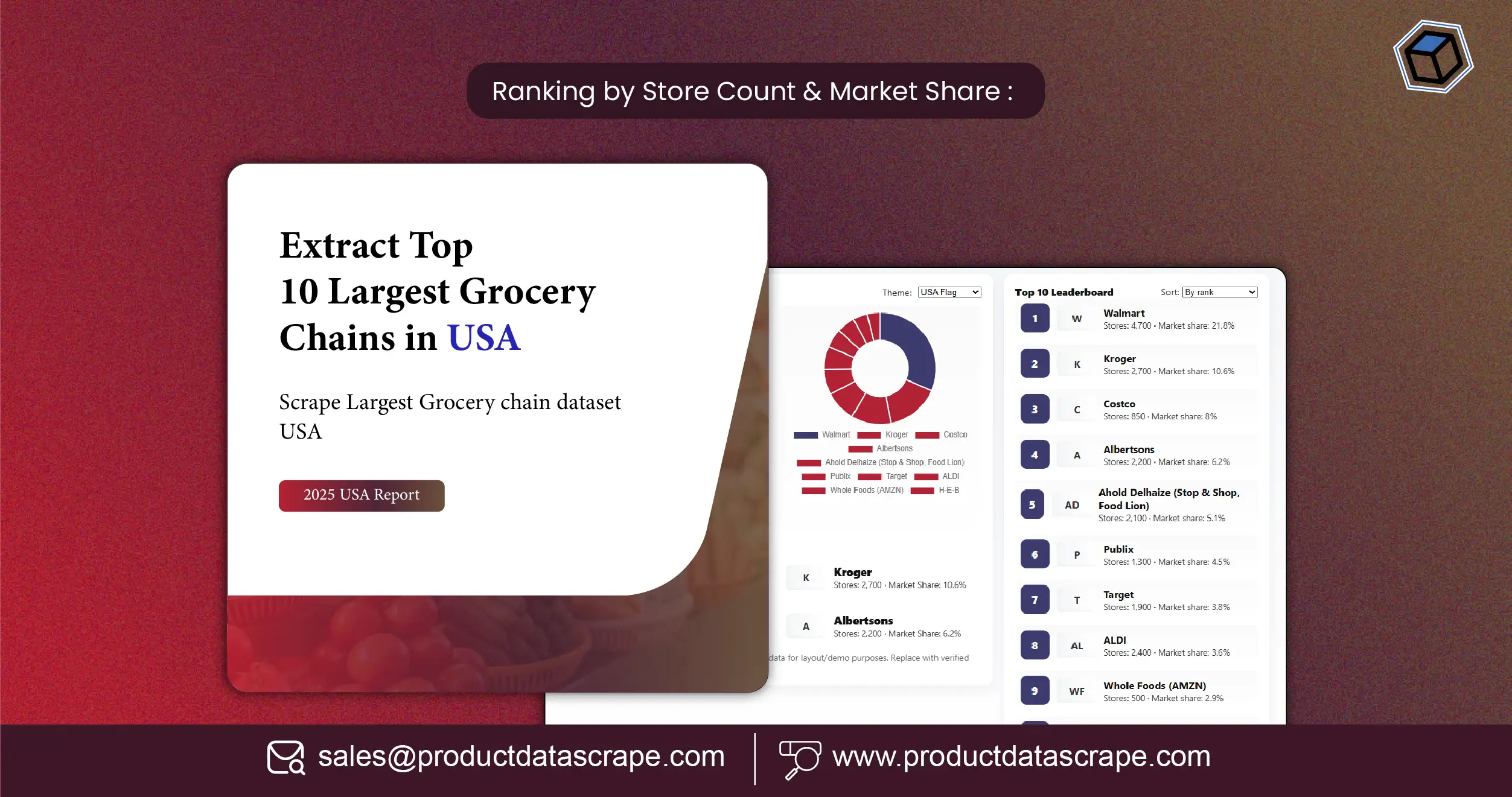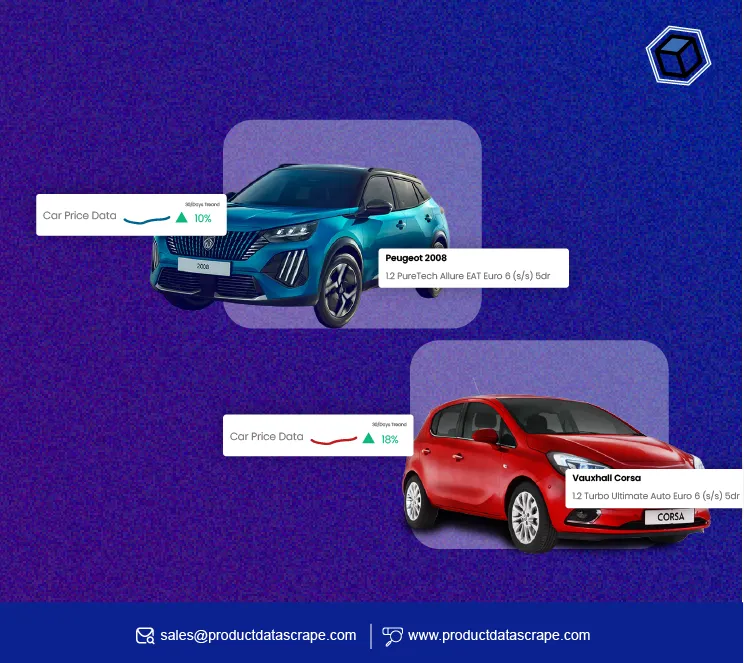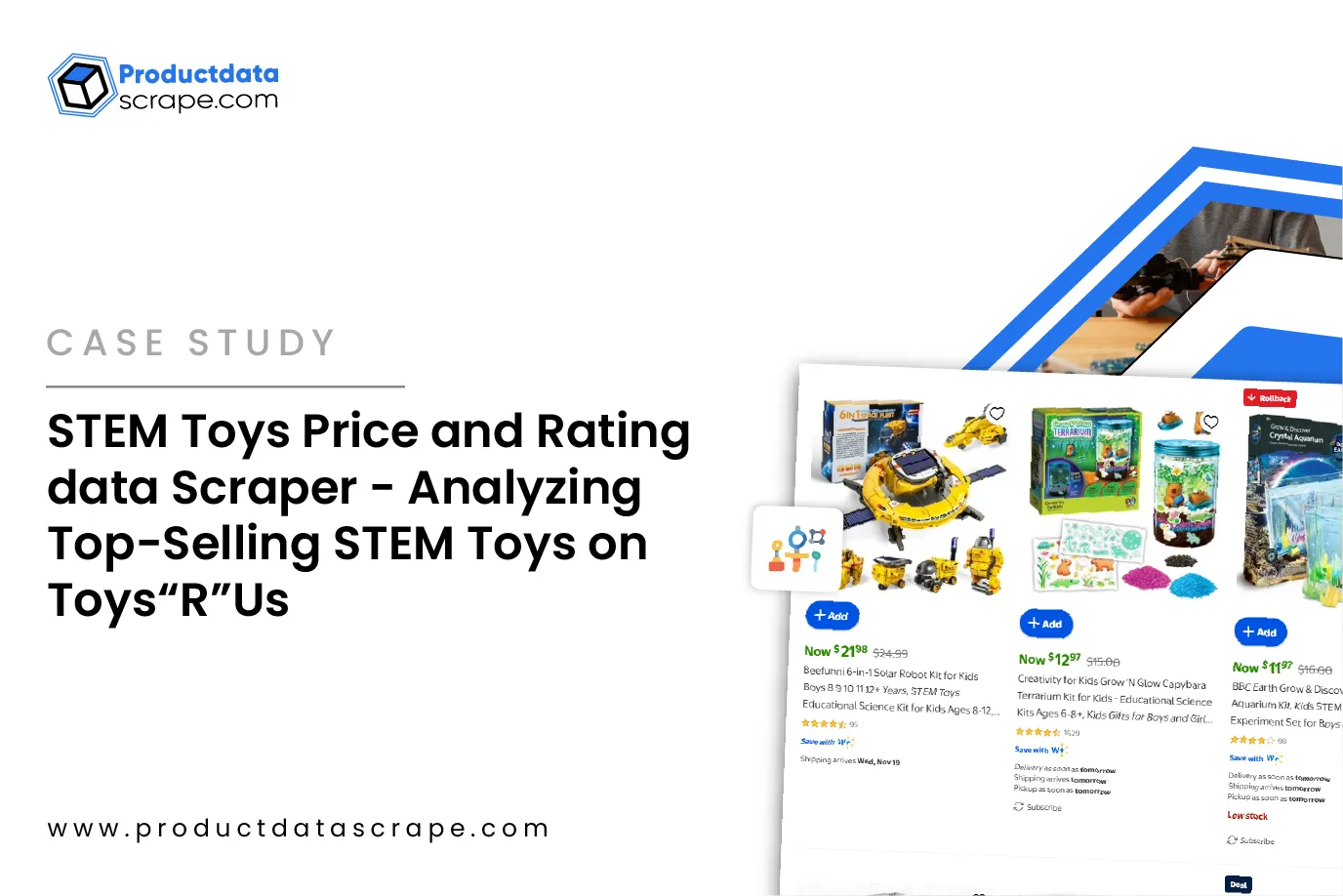
Introduction
The grocery retail landscape in the United States is rapidly evolving, driven by changing
consumer behaviors, digital adoption, and the rise of e-commerce and quick commerce platforms.
Retailers are constantly competing to expand their footprint, optimize operations, and
understand market dynamics. For businesses, analysts, and investors, having access to accurate
and timely data about leading grocery chains is critical to making informed decisions.
With Product Data Scrape, organizations can Extract Top 10 Largest Grocery Chains in USA 2025
efficiently, providing detailed insights on store count, market share, sales data, and product
offerings. Scraping tools allow businesses to Extract Market Share of Top US Supermarkets 2025,
uncovering trends and performance benchmarks for competitive strategy. Additionally, web
scraping facilitates the collection of granular information, such as product pricing, inventory
levels, and promotional campaigns, across major supermarket chains.
From Scrape Largest Grocery chain dataset USA to building a Grocery Store Product Dataset USA ,
modern scraping solutions ensure businesses stay ahead in an increasingly competitive retail
environment. This blog explores six practical applications of data scraping for understanding
and leveraging the US grocery market, supported by 2020–2025 data trends, tables, and actionable
insights.
Unlock powerful insights! Scrape and analyze store sales data of US
grocery chains to drive smarter decisions and growth today.
Contact Us Today!
Extract Market Share of Top US Supermarkets 2025
Market share is the ultimate indicator of dominance in the U.S. grocery retail space. In 2025,
the top 10 largest grocery chains control more than 70% of the total U.S. grocery market,
projected at $864 billion. Understanding the distribution of this market is essential for
investors, retailers, and analysts to identify opportunities and risks.
| Grocery Chain |
2020 Market Share (%) |
2021 |
2022 |
2023 |
2024 |
2025* |
| Walmart |
21 |
21.3 |
21.7 |
22 |
22.5 |
22.8 |
| Kroger |
10 |
10.2 |
10.5 |
10.7 |
11 |
11.2 |
| Costco |
6 |
6.2 |
6.5 |
6.7 |
7 |
7.3 |
| Albertsons |
4 |
4.1 |
4.2 |
4.3 |
4.4 |
4.5 |
| Ahold Delhaize |
3 |
3.1 |
3.2 |
3.3 |
3.4 |
3.5 |
| Target |
2 |
2.1 |
2.2 |
2.3 |
2.4 |
2.5 |
| Publix |
2 |
2.1 |
2.2 |
2.3 |
2.4 |
2.5 |
| H-E-B |
2 |
2.1 |
2.2 |
2.3 |
2.4 |
2.5 |
| Meijer |
1.5 |
1.5 |
1.6 |
1.6 |
1.7 |
1.8 |
| Whole Foods |
1 |
1.1 |
1.2 |
1.3 |
1.3 |
1.4 |
Over five years, Walmart’s steady growth reflects its omni-channel strategy, combining physical
stores with online grocery and delivery. Kroger’s rise is fueled by private-label expansion and
digital transformation. Costco leverages its membership model to increase basket size, while
Whole Foods captures the niche organic segment. By leveraging Extract US Grocery Chain Market
Insights, businesses can track annual shifts, regional variations, and emerging competitors.
Scrape Largest Grocery Chain Dataset USA
Collecting comprehensive datasets from top grocery chains is essential for strategic analysis,
competitive benchmarking, and supply chain optimization. Using Scrape Largest Grocery Chain
Dataset USA, businesses can obtain structured information on store count, regional distribution,
revenue, product categories, and pricing.
| Grocery Chain |
2020 Stores |
2021 |
2022 |
2023 |
2024 |
2025* |
| Walmart |
4,600 |
4,625 |
4,650 |
4,680 |
4,700 |
4,730 |
| Kroger |
2,750 |
2,760 |
2,780 |
2,800 |
2,820 |
2,840 |
| Costco |
550 |
575 |
600 |
625 |
650 |
675 |
| Albertsons |
2,200 |
2,210 |
2,220 |
2,230 |
2,240 |
2,250 |
| Ahold Delhaize |
2,000 |
2,020 |
2,040 |
2,060 |
2,080 |
2,100 |
| Target |
1,900 |
1,920 |
1,940 |
1,960 |
1,980 |
2,000 |
| Publix |
1,250 |
1,270 |
1,290 |
1,310 |
1,330 |
1,350 |
| H-E-B |
400 |
420 |
440 |
460 |
480 |
500 |
| Meijer |
250 |
255 |
260 |
265 |
270 |
275 |
| Whole Foods |
500 |
510 |
520 |
530 |
540 |
550 |
Extract Store Sales Data of US Grocery Chains
Understanding store-level sales performance is critical for evaluating profitability,
operational efficiency, and market positioning. By using Extract Store Sales Data of US Grocery
Chains, businesses can track revenue trends, category performance, and identify underperforming
locations.
| Grocery Chain |
2020 Sales ($B) |
2021 |
2022 |
2023 |
2024 |
2025* |
| Walmart |
370 |
380 |
390 |
400 |
410 |
420 |
| Kroger |
132 |
135 |
138 |
142 |
145 |
150 |
| Costco |
160 |
165 |
170 |
175 |
180 |
185 |
| Albertsons |
62 |
64 |
66 |
68 |
70 |
72 |
| Ahold Delhaize |
60 |
62 |
64 |
66 |
68 |
70 |
| Target |
40 |
42 |
44 |
46 |
48 |
50 |
| Publix |
38 |
39 |
40 |
41 |
42 |
43 |
| H-E-B |
35 |
36 |
37 |
38 |
39 |
40 |
| Meijer |
25 |
26 |
27 |
28 |
29 |
30 |
| Whole Foods |
20 |
21 |
22 |
23 |
24 |
25 |
Data indicates that Walmart’s grocery sales grow steadily by 2–3% annually, attributed to store
expansion and e-commerce integration. Kroger and Costco demonstrate higher growth percentages
(3–4%) due to private-label success and membership models. Smaller chains like Publix and H-E-B
maintain steady growth, highlighting their loyal regional customer base.
Scraping sales data allows analysts to segment performance by region, product category, and
store size. For example, Kroger’s midwestern stores see 10–15% higher sales in private-label
categories than national averages. Similarly, Costco’s bulk packages contribute
disproportionately to revenue during holiday seasons, with spikes of 20% in November–December.
Moreover, combining store sales data with competitor pricing scraped from Scrape Data from Top
Supermarkets in USA enables predictive modeling. Retailers can forecast demand shifts, optimize
inventory, and adjust promotional strategies in near real-time.
Actionable Insight: Chains can prioritize stocking high-margin products in high-performing
stores while adjusting inventory in underperforming regions, maximizing revenue per square foot.
Unlock powerful insights! Scrape and analyze store sales data of US
grocery chains to drive smarter decisions and growth today.
Contact Us Today!
Grocery Store Product Dataset USA
A comprehensive Grocery Store Product Dataset USA is essential for retailers, analysts, and
e-commerce platforms to understand product assortments, pricing strategies, and category trends.
By scraping product data across the top 10 grocery chains, businesses can monitor SKU
availability, pricing fluctuations, promotional campaigns, and customer preferences.
| Grocery Chain |
2020 SKUs |
2021 |
2022 |
2023 |
2024 |
2025* |
| Walmart |
110,000 |
112k |
115k |
118k |
120k |
122k |
| Kroger |
85,000 |
87k |
90k |
92k |
94k |
96k |
| Costco |
25,000 |
26k |
27k |
28k |
29k |
30k |
| Albertsons |
50,000 |
51k |
52k |
53k |
54k |
55k |
| Ahold Delhaize |
48,000 |
49k |
50k |
51k |
52k |
53k |
| Target |
38,000 |
39k |
40k |
41k |
42k |
43k |
| Publix |
32,000 |
33k |
34k |
35k |
36k |
37k |
| H-E-B |
28,000 |
29k |
30k |
31k |
32k |
33k |
| Meijer |
20,000 |
21k |
22k |
23k |
24k |
25k |
| Whole Foods |
18,000 |
19k |
20k |
21k |
22k |
23k |
Analysis shows Walmart and Kroger lead in product diversity, reflecting large-scale operations
and multi-category offerings. Whole Foods maintains a smaller SKU count, emphasizing organic and
specialty items. Bulk-focused chains like Costco have fewer SKUs but high sales velocity per
item. Scraping product datasets provides real-time visibility into pricing and promotions,
crucial during peak seasons.
For instance, Walmart’s online catalog reveals 5–10% price fluctuations weekly on high-demand
items, while Kroger’s private-label products maintain a consistent 15–20% discount compared to
national brands. By integrating Extract Grocery & Gourmet Food Data , businesses can analyze
category performance over time, identify gaps in product assortments, and optimize inventory.
Historical data from 2020–2025 shows that specialty organic products have increased 25% in SKU
count, highlighting the growing consumer preference for health-oriented groceries.
Actionable Insight: Chains can align marketing campaigns with trending product
categories identified via scraping, ensuring higher sales and better customer engagement.
Quick Commerce Grocery & FMCG Data Scraping
The rise of quick commerce has transformed grocery retail, emphasizing speed, convenience, and
digital-first strategies. Using Quick Commerce Grocery & FMCG Data Scraping , retailers can
monitor online product catalogs, real-time pricing, flash promotions, and inventory across
platforms like Walmart Grocery, Instacart, and Amazon Fresh.
| Chain/Platform |
2020 SKUs |
2021 |
2022 |
2023 |
2024 |
2025* |
| Walmart Online |
80,000 |
85k |
90k |
95k |
100k |
105k |
| Kroger Digital |
60,000 |
63k |
66k |
70k |
73k |
75k |
| Target Online |
35,000 |
37k |
39k |
41k |
43k |
45k |
| Costco Online |
20,000 |
21k |
22k |
23k |
24k |
25k |
| Amazon Fresh |
50,000 |
52k |
54k |
56k |
58k |
60k |
Data scraping reveals seasonal trends, including spikes in FMCG sales during holidays, summer
BBQ season, and back-to-school periods. Walmart online reports 15–20% sales spikes for snack
foods and beverages in July–August, while Amazon Fresh sees 25% growth in organic staples during
winter holidays.
Scraping quick commerce data provides retailers with insights into competitor pricing, discount
strategies, and product availability. This enables dynamic pricing adjustments and inventory
planning in near real-time, reducing out-of-stock scenarios and lost sales. Additionally,
historical data (2020–2025) indicates a 30% increase in online SKU coverage across top chains,
reflecting the digital expansion trend.
Actionable Insight: Retailers can preemptively stock high-demand FMCG items
based on competitor data, ensuring faster fulfillment and higher conversion rates in digital
channels.
Supermarket Data Scraping Services
Supermarket Data Scraping Services like Instant Data Scraper provide businesses with structured,
actionable intelligence across top U.S. grocery chains. These services extract pricing, product
availability, promotions, inventory levels, and regional store performance in real-time.
| Service Type |
Scope |
Chains Covered |
Frequency |
| Product Data Scraping |
SKU, category, pricing |
Walmart, Kroger, Target, Costco |
Daily |
| Quick Commerce Scraping |
FMCG, digital SKUs, discounts |
Walmart, Amazon Fresh, Instacart |
Real-time |
| Store Performance Data |
Sales, revenue, inventory |
Top 10 grocery chains |
Weekly |
| Market Insights Analytics |
Market share, trends, growth |
Nationwide |
Monthly |
Scraping services allow analysts to combine Grocery Store Product Dataset USA with sales data,
competitor promotions, and seasonal trends, enabling advanced analytics and predictive modeling.
Historical trends (2020–2025) show Walmart’s online grocery catalog grew from 80,000 SKUs to
105,000, while Kroger increased from 60,000 to 75,000, reflecting digital expansion strategies.
By using scraping services, businesses can benchmark pricing strategies, monitor competitor
promotions, and identify market gaps. For example, tracking Whole Foods’ organic product
launches enables traditional supermarkets to introduce competitive alternatives and promotions.
Actionable Insight: Retailers leveraging scraping services can optimize
inventory, forecast seasonal demand, and adjust pricing in real-time, leading to improved
operational efficiency and market competitiveness.
Boost your retail strategy! Leverage supermarket data scraping services
to track products, pricing, and trends for smarter business decisions.
Contact Us Today!
Why Choose Product Data Scrape?
Product Data Scrape offers reliable, accurate, and scalable solutions to extract competitive
intelligence from grocery chains. From Scrape Data from Top Supermarkets in USA to building
Grocery & Gourmet Food Data datasets, our tools automate collection, cleaning, and analysis.
Companies gain access to:
- Real-time pricing and product insights
- Historical trends from 2020–2025
- Store-level and SKU-level granularity
- Quick commerce and FMCG analytics
With structured datasets, businesses can forecast sales, track competitors, optimize inventory,
and design promotional strategies. By leveraging Supermarket Data Scraping Services, companies
save time, reduce errors, and unlock actionable insights that drive revenue and market share
growth.
Conclusion
The US grocery sector is intensely competitive, and data-driven decisions are crucial for
success. By using Product Data Scrape to Extract Top 10 Largest Grocery Chains in USA 2025,
businesses gain a comprehensive view of store counts, market share, sales, and product
assortments. From Extract Store Sales Data of US Grocery Chains to Quick Commerce Grocery & FMCG
Data Scraping, every dataset empowers smarter strategies, better pricing decisions, and improved
operational efficiency.
Unlock actionable intelligence today—partner with Product Data Scrape to extract, analyze, and
leverage the most accurate and up-to-date grocery retail data. Transform raw data into insights,
outperform competitors, and make data-backed decisions for 2025 and beyond.
Boost your retail strategy with Product Data Scrape —extract, analyze, and act on top US grocery
chain data today!


.webp)

.webp)










.webp)
-01.webp)

.webp)
.webp)
.webp)